Indian wolf
The Indian wolf (Canis lupus pallipes) is a subspecies of grey wolf that ranges from Southwest Asia to the Indian Subcontinent. It is intermediate in size between the Himalayan wolf and the Arabian wolf, and lacks the former's luxuriant winter coat due to it living in warmer conditions.[2] Within this subspecies, the "Indian plains wolf" is genetically basal to all other extant Canis lupus apart from the older-lineage Himalayan wolf, with both proposed as separate species.[3][4] The Indian wolf travels in smaller packs and is less vocal than other variants of the grey wolf,[5] and has a reputation for being cunning.[6][7]
| Indian wolf | |
|---|---|
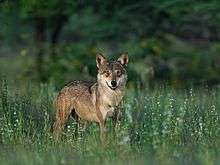 | |
| Indian wolf at Mayureshwar Wildlife Sanctuary in Pune district, Maharashtra, India. | |
| Scientific classification | |
| Kingdom: | Animalia |
| Phylum: | Chordata |
| Class: | Mammalia |
| Order: | Carnivora |
| Family: | Canidae |
| Genus: | Canis |
| Species: | C. lupus |
| Subspecies: | C. l. pallipes |
| Trinomial name | |
| Canis lupus pallipes | |
_distribution.png) | |
| Canis lupus pallipes distribution | |
Taxonomy
The Indian wolf was first described in 1831 by the British ornithologist William Henry Sykes under the binomial Canis pallipes.[1] In 1941, Reginald Pocock subordinated it to Canis lupus under the trinomial Canis lupus pallipes.[2]
Admixture with other Canis species
In 2018, whole genome sequencing was used to compare members of the genus Canis. The study found evidence of gene flow between African golden wolves, golden jackals, and grey wolves (from Saudi Arabia and Syria). One African golden wolf from the Egyptian Sinai Peninsula showed high admixture with the Middle Eastern grey wolves and dogs, highlighting the role of the land bridge between the African and Eurasian continents in canid evolution. The African golden wolf was found to be the descendant of a genetically admixed canid of 72% grey wolf and 28% Ethiopian wolf ancestry.[8]
Canis indica
| Phylogenetic tree with timing in years for Canis lupus[lower-alpha 1] | |||||||||||||||||||||||||||
|
The Indian plains wolf[9] (Canis lupus pallipes, synonym Canis indica) is formed by 2 closely related female lineage mitochondrial DNA (mDNA) haplotypes[4] that fall within the Canis lupus pallipes subspecies of the gray wolf. It is only found in the arid and semi-arid peninsular plains of India.[4] This wolf is genetically unique from all other wolves worldwide, including C. l. pallipes.[10][9] The Indian gray wolf and the Himalayan wolf are phylogenetically basal to all other wolves and are closer to the African golden wolf. This indicates that these are the descendants of an ancient wolf distribution.[4][9] In April 2009, the Latin binom Canis indica had been proposed for these 2 haplotypes as a nomenclatural and taxonomic split from Canis lupus as a new species through the Nomenclature Specialist on the CITES Animals Committee.[11] The committee recommended against this proposal but recommended that the name be entered into the species database as a synonym of the name under which it was listed.[12] The proposal was based on one study[4] that relied on only a limited number of museum and zoo samples that may not have been representative of the wild population, and a call for further fieldwork was made.[13]:886
Earlier, two studies had sequenced the mDNA of the Indian gray wolf and found that it is basal to all other extant Canis lupus haplotypes apart from the older-lineage Himalayan wolf.[3][4] Later studies compared these sequences against worldwide wolf sequences and confirmed this basal position.[14][15][16] One study, based on a fossil record estimate that the divergence time between the coyote and the wolf lineages occurred 1 million years ago and with an assumed wolf mutation rate, estimated the time of divergence of the Indian gray wolf from the wolf/dog ancestor to be 400,000 years ago.[3]:S2 Another study, which expressed concerns about the earlier study, gave an estimate of 270,000 ago years.[4]:169
The Indian grey wolf is endangered and its population is estimated at 2,000-3,000.[3] It resembles C. l. pallipes in its outer appearance (morphological features) and its social/reproductive behavior, but it is smaller in size. It is genetically distinct from C. l. pallipes. These findings suggest that the Indian gray wolf is not the pallipes found in the Middle East and Central Asia.[4]:169 It was therefore proposed that the Indian gray wolf be reclassified as a separate species Canis indica.[3][4] In 2016, a study of the mDNA of both modern and ancient wolves indicated that the Indian gray wolf and the Himalayan wolf were genetically basal when compared with all other grey wolves.[17]
The taxonomic reference Mammal Species of the World (2005) does not recognize Canis indica, however NCBI/Genbank does list Canis lupus indica.[18]
Description and habits
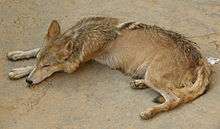
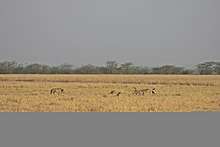
The Indian wolf is similar in structure to the European wolf, but is smaller, more slightly built, and has shorter fur with little to no underfur.[6] It is typically around 57–72 cm (22–28 in) at shoulder height, with males ranging from 19–25 kg (42-55 lb) and females 17–22 kg (37-49 lb) in weight. Its length ranges from 103–145 cm (41–57 in) from nose to tail.[19] Like the Arabian wolf, it has short, thin fur in summer, though the hair on the back remains long even in summer, an adaptation thought to be against solar radiation.[20] The fur is generally greyish-red to reddish-white with grey tones. The hairs are grizzled with black, particularly on the back, which sports a dark V-shaped patch around the shoulders. The limbs are paler than the body, and the underparts are almost completely white.[5] Pups are born sooty-brown, with a milk-white patch on the chest that fades with age.[6] Black specimens are rare, but have been recorded in India's Solapur district and two regions of Iran. In the latter country, the mutation was found to be naturally occurring, unlike in North American grey wolves, which have inherited the Kb allele responsible for melanism from past interbreeding with dogs.[21][22]
Its habits are similar to those of other grey wolf subspecies, though the Indian wolf generally lives in smaller packs rarely exceeding 6-8 individuals, and is relatively less vocal,[6] having rarely been known to howl.[5] Indian wolf vocalization includes howls, howl-barks, whimper, social squeals, and whines with howls an average fundamental frequency of 422 Hz and whines 906 Hz.[23] There is at least one record of a lone wolf associating with a pair of dholes in Debrigarh Wildlife Sanctuary.[24] It tends to breed from mid-October to late December, and whelp in holes or ravines.[5] It typically preys on antelopes, rodents, and hares.[25] It usually hunts in pairs when targeting antelopes, with one wolf acting as a decoy while the other attacks from behind.[6] The range of the Indian wolf overlaps with the golden jackal, sloth bear, leopard, brown bear, Asiatic lion and tiger.[26][27]
Hunting
Indian wolves are nocturnal and hunt from dusk to dawn, using different strategies for their various prey animals.[28] These wolves are said to be exceptional in speed and endurance.[5] An Indian wolf pack will spread themselves out when hunting Indian hares and various rodents, in contrast to coordinating when their target is the swift blackbuck antelope. The blackbuck is the major prey animal for wolves in Nannaj and Blackbuck National Park and constitute up to 88% of Indian wolf biomass consumption.[29] Because the antelope is faster, Indian wolves will usually chase it toward ravines, bushes or hollows, where more wolves wait in ambush.[6][30] In addition to leading antelopes into an ambush, Indian wolves can chase blackbucks down hills for a short-term burst in speed. Indian wolves may also select a sick or injured animal and separate it from the herd, pursuing it to exhaustion. This strategy is commonly seen in grey wolves, and often proves successful. Finally, when they close the distance and attack, a single wolf would grab the snout to asphyxiate the antelope while others attack the rear.[30] Indian wolves are also reported to use curiosity to lure antelopes in for a kill. One story remarks that a wolf rolled over, legs upright, when the blackbucks were feeding. When the antelope accidentally disturbed this wolf, two others sprung up for the kill.[6]
Range and status
West Asia
During the 19th century, wolves were widespread in many parts of the Holy Land east and west of the Jordan River. However, they decreased considerably in number between 1964 and 1980, largely due to persecution by farmers.[31] Currently, Israel's conservation policies and effective law enforcement maintain a moderately sized wolf population, which radiates into neighbouring countries. Turkey may play an important role in maintaining wolves in the region, due to its contiguity with Central Asia. The mountains of Turkey have served as a refuge for the few wolves remaining in Syria. A small wolf population occurs in the Golan Heights, and is well protected by the military activities there.[32] Although Turkish wolves have no legal protection, they may number about 7,000 individuals.[33]
Little is known of current wolf populations in Iran, which once occurred throughout the country in low densities during the mid-1970s.[32] Although widespread throughout the country, being absent only in the central desert and Dasht-e Lut, there is no reliable estimation on the wolf's population size there. Wolves in Iran continue to suffer from habitat loss, unregulated hunting and loss of prey.[34][35]
Indian subcontinent
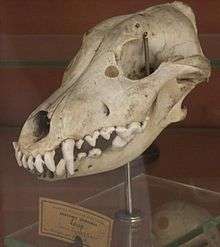
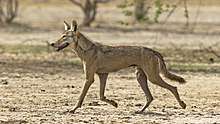
The northern regions of Afghanistan and Pakistan are important strongholds for the wolf. It has been estimated that there are about 300 wolves in approximately 60,000 km2 (23,000 sq mi) of Jammu and Kashmir in northern India, and 50 more in Himachal Pradesh.[32] Hindus traditionally considered the hunting of wolves, even dangerous ones, as taboo, for fear of causing a bad harvest. The Santals, however, considered them fair game, as with every other forest-dwelling animal.[36] During British rule in India, wolves were not considered game species, and were killed primarily in response to them attacking game herds, livestock, and people. In 1876, in the North-West Provinces and Bihar State, 2,825 wolves were killed in response to 721 fatal attacks on humans.[37] Two years later, 2,600 wolves were killed in response to attacks leaving 624 humans dead.[38] By the 1920s, wolf extermination remained a priority in the NWP and Awadh. Overall, over 100,000 wolves were killed for bounties in British India between 1871 and 1916.[37] In modern India, the Indian wolf is distributed across the states of Gujarat, Rajasthan, Haryana, Uttar Pradesh, Madhya Pradesh, Maharashtra, Karnataka and Andhra Pradesh. As of 2004, it is estimated that there are around 2000–3000 Indian wolves in the country.[39] They are mainly found outside of protected reserves and feed mainly on domestic animals, such as goats or sheep. However, in areas where natural prey is still abundant, for example in Velavadar National Park or Panna Tiger Reserve, natural prey species are still preferred.[40] Although protected since 1972, Indian wolves are classed as Endangered, with many populations lingering in low numbers or living in areas increasingly used by humans. Although present in Bhutan, there is no information on the wolves occurring there.[32]
Relationships with humans
Attacks on humans
Indian wolves have a history of preying on children, a phenomenon called "child-lifting". In 1878, 624 people were killed by wolves in Uttar Pradesh, and 14 others were killed in Bengal during the same period.[41] In 1900, 285 people were killed in the Central Provinces.[42] Between 1910 and 1915, 115 children were killed by wolves in Hazaribagh, and 122 were killed in the same area in 1980–1986. In Jaunpur, Pratapgarh and Sultanpur in Uttar Pradesh, wolves killed 21 children and mauled 16 others from March 27, 1996 to July 1, 1996. Between April 1993 and April 1995, five wolf packs attacked 80 children, 20 of whom were rescued, in Hazaribagh, West Koderma and Latehar Forest Divisions. The children were taken primarily in the summer period in the evening hours, and often within human settlements.[41]
In Iran, wolf attacks have been reported for millennia. As with India, many cases of wolves making off with small children have been reported. Adults have been attacked on occasion, including an incident in which a policeman was killed and partially eaten by three wolves after dismounting from his horse to relieve himself.[43] On January 2, 2005 in the village of Vali Asr, near the town of Torbat Heydariya, northeastern Iran, a wolf pack attacked a homeless man in front of witnesses. Although the police intervened, the man died of his wounds.[44] In early November 2008, a media report claimed that a wolf had attacked an 87-year-old woman in the village cemetery of Kashan in central Iran, biting off one of her fingers, but was suffocated to death when she fought back.[45]
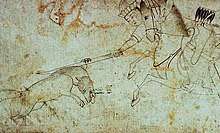
Predation on Livestock
Indian wolves will feed on livestock when natural prey is scarce. This causes human-wolf conflicts and wolf persecution since human population density is high in these areas.[46] Grass is quickly grazed by livestock in unprotected grasslands that cannot sustain a blackbuck population afterward.[30] Among domestic animals, goats are the primary target for Indian wolves, comprising 66% of wolf attacks around the Jhelum district, with sheep following at 27%.[47] Wolves are also more prone to preying on livestock during denning periods and with pups below 5–6 months old.[30] It is not uncommon for locals to exaggerate the magnitude of Indian wolf depredation and tell tales of their predatory wiles, contributing to hatred of the animal.[6][7][30]
In culture
Like the fox and the coyote, the Indian wolf has a reputation for being clever. There are many stories of their stratagems told by locals, observers and shepherds.[6][7] The people of Maharashtra would sing labad landga dhong kartay, which translates to "Wolves are clever animals and will fool you with their devilish methods."[48]
Wolves are occasionally mentioned in Hindu mythology. In the Harivamsa, Krishna, to convince the people of Vraja to migrate to Vrindavan, creates hundreds of wolves from his hairs, which frighten the inhabitants of Vraja into making the journey.[49] In the Rig Veda, Rijrsava is blinded by his father as punishment for having given 101 of his family's sheep to a she-wolf, who in turn prays to the Ashvins to restore his sight.[50] Bhima, the voracious son of the god Vayu, is described as Vrikodara, meaning "wolf-stomached".[51]
The wolf has an ambivalent reputation in Iranian culture, being demonised in the Avestas as a creation of Ahriman,[50] and still features in contemporary cautionary tales told to misbehaving children.[52]
Indian wolves take a central role in Rudyard Kipling's The Jungle Book series, in which a pack in the Seoni area of Madhya Pradesh adopts the feral child Mowgli, and teaches him how to survive in the jungle whilst protecting him from the Bengal tiger Shere Khan and the marauding dhole.
Notes
- For a full set of supporting references refer to the note (a) in the phylotree at Evolution of the wolf#Wolf-like canids
References
- Sykes, William H. (1831). "Catalogue of the Mammalia of Dukun (Deccan); with observations on the habits, etc., and characters of new species". Proceedings of the Committee of Science and Correspondence of the Zoological Society of London 1830–1831. London: Zoological Society of London. I: 101. Retrieved 28 December 2013.
- Pocock, R. I. (1941), Fauna of British India: Mammals volume 2, Taylor & Francis, pp. 82-94
- Sharma, D. K.; Maldonado, J. E.; Jhala, Y. V.; Fleischer, R. C. (2004). "Ancient wolf lineages in India". Proceedings of the Royal Society B: Biological Sciences. 271 (Suppl 3): S1–S4. doi:10.1098/rsbl.2003.0071. PMC 1809981. PMID 15101402.
- Aggarwal, R. K.; Kivisild, T.; Ramadevi, J.; Singh, L. (2007). "Mitochondrial DNA coding region sequences support the phylogenetic distinction of two Indian wolf species". Journal of Zoological Systematics and Evolutionary Research. 45 (2): 163–172. doi:10.1111/j.1439-0469.2006.00400.x.
- Mivart, G. (1890), Dogs, Jackals, Wolves and Foxes: A Monograph of the Canidæ, London: R.H. Porter : Dulau, pp. 9-10
- Blanford, W. T. (1888), Fauna of British India: Mammalia, London, Taylor and Francis, pp. 137-40
- Senani Hegde (Director) (27 February 2015). Walking with Wolves [Walking with Wolves] (Motion Picture). Krupakar, Bobby. Retrieved 1 January 2020.
- Gopalakrishnan, Shyam; Sinding, Mikkel-Holger S.; Ramos-Madrigal, Jazmín; Niemann, Jonas; Samaniego Castruita, Jose A.; Vieira, Filipe G.; Carøe, Christian; Montero, Marc de Manuel; Kuderna, Lukas; Serres, Aitor; González-Basallote, Víctor Manuel; Liu, Yan-Hu; Wang, Guo-Dong; Marques-Bonet, Tomas; Mirarab, Siavash; Fernandes, Carlos; Gaubert, Philippe; Koepfli, Klaus-Peter; Budd, Jane; Rueness, Eli Knispel; Heide-Jørgensen, Mads Peter; Petersen, Bent; Sicheritz-Ponten, Thomas; Bachmann, Lutz; Wiig, Øystein; Hansen, Anders J.; Gilbert, M. Thomas P. (2018). "Interspecific Gene Flow Shaped the Evolution of the Genus Canis". Current Biology. 28 (21): 3441–3449.e5. doi:10.1016/j.cub.2018.08.041. PMC 6224481. PMID 30344120.
- Spotte, Stephen (2012). "1-What makes a wolf?". Societies of Wolves and Free-ranging Dogs. Cambridge University Press, Cambridge, UK. p. 4. ISBN 978-1-107-01519-7.
- Aggarwal, Ramesh K. (2007). "7-Molecular Genetic Studies on highly Endangered Species". In M. W. Pandit; S. Shivaji; Lalji Singh (eds.). You Deserve, We Conserve: A Biotechnological Approach to Wildlife Conservation. I K International Publishing House, New Dehli. pp. 54–57. ISBN 978-81-89866-24-2.
- "Nomenclatural Matters. Twenty-fourth meeting of the Animals Committee Geneva, (Switzerland), 20–24 April 2009, AC24 Doc. 13 Rev. 1 Annex 1" (PDF). CITES. 2009. p. 3.
- "Summary Record. Twenty-fourth meeting of the Animals Committee Geneva, (Switzerland), 20–24 April 2009, AC24 Summary Record" (PDF). CITES. 2009. p. 28.
- Shrotriya; Lyngdoh; Habib (October 25, 2012). "Wolves in Trans-Himalayas: 165 years of taxonomic confusion" (PDF). Current Science. 103 (8). Retrieved June 27, 2014.
- Miklosi, Adam (2015). Dog Behaviour, Evolution, and Cognition. Oxford Biology (2nd ed.). Oxford University Press. pp. 106–107. ISBN 978-0199545667.
- Leonard, J. A.; Vilà, C; Fox-Dobbs, K; Koch, P. L.; Wayne, R. K.; Van Valkenburgh, B (2007). "Megafaunal extinctions and the disappearance of a specialized wolf ecomorph" (PDF). Current Biology. 17 (13): 1146–50. doi:10.1016/j.cub.2007.05.072. PMID 17583509.
- Pilot, M. G.; Branicki, W.; Jędrzejewski, W. O.; Goszczyński, J.; Jędrzejewska, B. A.; Dykyy, I.; Shkvyrya, M.; Tsingarska, E. (2010). "Phylogeographic history of grey wolves in Europe". BMC Evolutionary Biology. 10: 104. doi:10.1186/1471-2148-10-104. PMC 2873414. PMID 20409299.
- Ersmark, Erik; Klütsch, Cornelya F. C.; Chan, Yvonne L.; Sinding, Mikkel-Holger S.; Fain, Steven R.; Illarionova, Natalia A.; Oskarsson, Mattias; Uhlén, Mathias; Zhang, Ya-Ping; Dalén, Love; Savolainen, Peter (2016). "From the Past to the Present: Wolf Phylogeography and Demographic History Based on the Mitochondrial Control Region". Frontiers in Ecology and Evolution. 4. doi:10.3389/fevo.2016.00134.
- "Canis lupus indica".
- "National Studbook: Indian Wolf (Canis lupus pallipes)" (PDF). Central Zoo Authority, Government of India. Wildlife Institute of India. Retrieved 1 January 2020.
- Harrington, F. H. & Paquet, P. C. (1982). Wolves of the World: Perspectives of Behavior, Ecology, and Conservation. Park Ridge, N.J: Noyes Publications. ISBN 0-8155-0905-7
- Lokhande, A. S.; Bajaru, S. B. (2013). "First Record of Melanistic Indian Wolf Canis lupus pallipes from the Indian Subcontinent". Journal of the Bombay Natural History Society. 110 (3): 220–30.
- Khosravi, R (2014). "Is black coat color in wolves of Iran an evidence of admixed ancestry with dogs?". Journal of Applied Genetics. 56: 97–105. doi:10.1007/s13353-014-0237-6. PMID 25085671.
- Sadhukhan (31 October 2019). "Characterising the harmonic vocal repertoire of the Indian wolf (Canis lupus pallipes)". PLOS ONE. 14 (10): e0216186. doi:10.1371/journal.pone.0216186. PMC 6822943. PMID 31671161.
- Nair, M. V.; Panda, S. K. (2013). "Just Friends". Sanctuary Asia. XXXIII (3).
- Yadvendradev, V. Jhala (December 1993). "Predation on Blackbuck by Wolves in Velavadar National Park, Gujarat, India". Conservation Biology. Wiley & Sons. 7 (4): 874–881. doi:10.1046/j.1523-1739.1993.740874.x. JSTOR 2386819.
- Heptner, V. G.; Sludskij, A. A. (1992) [1972]. "Lion". Mlekopitajuščie Sovetskogo Soiuza. Moskva: Vysšaia Škola [Mammals of the Soviet Union. Volume II, Part 2. Carnivora (Hyaenas and Cats)]. Washington DC: Smithsonian Institution and the National Science Foundation. pp. 82–93.
- Negi, Sharad Singh (2002), Handbook of National Parks, Wildlife Sanctuaries and Biosphere Reserves in India (3rd ed.), Indus Publishing, p. 151, ISBN 978-81-7387-128-3
- "Indian Wolf". Wolf Worlds. Retrieved 1 January 2020.
- Jhala, Yadvendradev V. "Predation on Blackbuck by Wolves in Velavadar National Park, Gujarat, India". Wolves: Wolf History, Conservation, Ecology and Behavio. Retrieved 1 January 2020.
- Kumar, Satish. "Ecology and Behavior of Indian Grey Wolf (Canis lupus pallipes Sykes, 1831) in the Deccan Grasslands of Solapur, Maharashtra" (PDF). AMU Repository. Retrieved 1 January 2020.
- Qumsiyeh, Mazin B. (1996). Mammals of the Holy Land. Texas Tech University Press, pp. 146–148, ISBN 089672364X
- Mech, L. David; Boitani, Luigi (2003). Wolves: Behaviour, Ecology and Conservation. University of Chicago Press. p. 326-27. ISBN 0-226-51696-2.
- Zuppiroli, Pierre; Donnez, Lise (2006). "An Interview with Ozgun Emre Can on the Wolves in Turkey" (PDF). UKWCT. 26: 8–9. Archived from the original (PDF) on 2011-07-27.
- Khosravi, R.; et al. (2012). "Morphometric variations of the skull in the Gray Wolf (Canis lupus) in Iran". Acta Theriol. 57: 361–369. doi:10.1007/s13364-012-0089-6.
- Khosravi, R.; Rezaei, H.R.; Kaboli, M. (2013). "Detecting hybridization between Iranian wild wolf (Canis lupus pallipes) and free-ranging domestic dog (Canis familiaris) by analysis of microsatellite markers". Zool. Sci. 30 (1): 27–34. doi:10.2108/zsj.30.27. PMID 23317363.
- Maclean, Charles (1980). The Wolf Children. Harmondsworth, Eng.; New York: Penguin Books. p. 336. ISBN 0-14-005053-1.
- Knight, John (2004). Wildlife in Asia: Cultural Perspectives. Psychology Press, pp. 219–221, ISBN 0700713328
- Bright, Michael (2002). Man-Eaters. New York: St. Martin's Paperbacks. p. 304. ISBN 0-312-98156-2.
- Yadvendradev, V. Jhala; Giles, Robert H. Jr. (December 1991). "The Status and Conservation of the Wolf in Gujarat and Rajasthan, India". Conservation Biology. Wiley. 5 (4): 476–483. doi:10.1111/j.1523-1739.1991.tb00354.x. JSTOR 2386069.
- Singh, Mewa; Kumara, H. N. (2006). "Distribution, status and conservation of Indian gray wolf (Canis lupus pallipes) in Karnataka, India". Journal of Zoology. 270 (1): 164–169. doi:10.1111/j.1469-7998.2006.00103.x.
- Rajpurohit, K.S. (1999). "Child lifting: Wolves in Hazaribagh, India". Ambio. 28: 162–166.
- Burton, R.G. (1991). A Book of Man Eaters. Mittal Publications.
- Mader, T. R. "Wolf Attacks on Humans". Abundant Wildlife Society of North America. Archived from the original on 29 May 2007. Retrieved 28 December 2013.
- Homeless man eaten by wolves in Iran. Iranfocus (2005-01-04)
- Wolf slain by 87-year-old Iranian woman Archived 2012-09-26 at the Wayback Machine. presstv.ir (2008-11-08).
- Krithivasan, Roopa; Athreya, Vidya R.; Odden, Morten. "Human-Wolf Conflict in human dominated landscapes of Ahmednagar District, Maharashtra & Possible Mitigation Measures" (PDF). Project Waghoba.
- Saad, Muhammed; Anwar, Maqsood; Waseem, Muhammad; Salim, Mohammed; Ali, Zulfiqar (January 2015). "Distribution range and population status of Indian grey wolf (Canis Lupus Pallipes) and Asiatic jackal (Canis aureus) in Lehri Nature Park, District Jhelum, Pakistan". Journal of Animal and Plant Sciences. 25 (3). Retrieved 2 January 2020.
- Banerjee, Ananda. "India's disregarded wolves". DownToEarth. Retrieved 2 March 2020.
- Wilson, H. H., Hall, F. (1868). The Vishńu Puráńa: A System of Hindu Mythology and Tradition. Trubner
- Krishna Murthy, K. (1985). Mythical animals in Indian art. Abhinav Publications, ISBN 0-391-03287-9
- Wilkins, W. J. (2004). Hindu Mythology, Vedic and Puranic. S.l: Kessinger Publishing. ISBN 0-7661-8881-7.
- Humphreys, P. & Kahrom, E. (1999). Lion and Gazelle: The Mammals and Birds of Iran. I.B.Tauris. pp. 88-9. ISBN 1860642292
External links
| Wikispecies has information related to Canis lupus pallipes |
| Wikimedia Commons has media related to Canis lupus pallipes. |